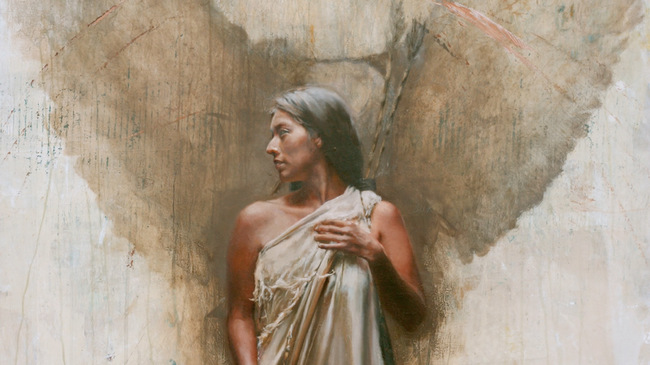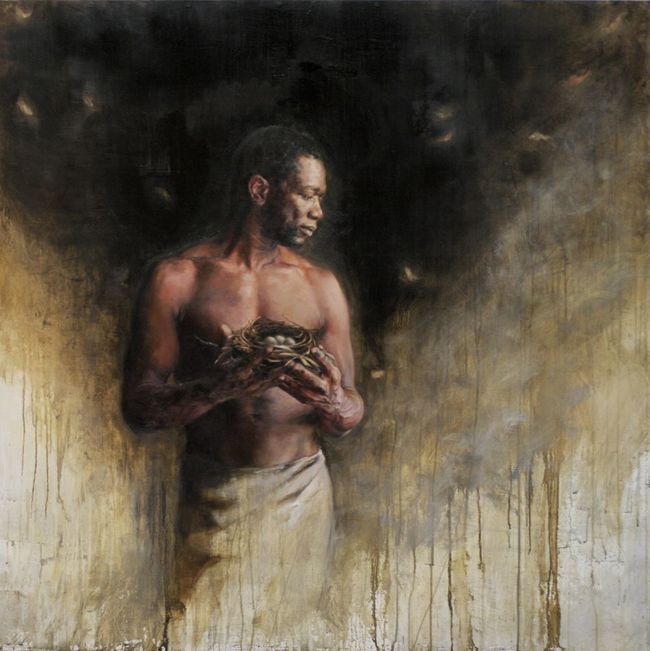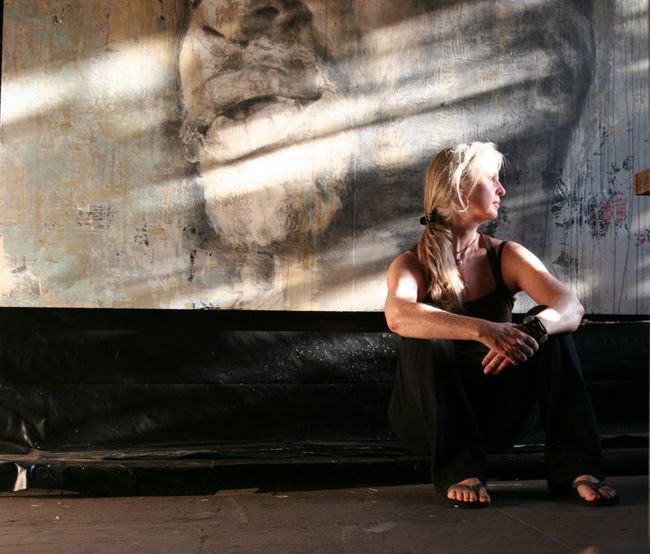Interview with Suzy Schultz
I really do love the conversation. I am more interested in hearing what other people have to say than what I have to say. In that vein, here I interview one of my favorite artists today, Suzy Schultz. Her website is in the title link above. Be sure to check it out.
On your website you have your artistic vision and you talk about the two innocences, What I want to hear more about is that Second Innocence. What is it that makes it an Innocence and what appeals to you?
I heard that term in an interview in an article years ago. The guy quoted a French theologian, the theologian used that term Second Innocence. I don’t know what it is about that term, I have some ideas. It kind of goes with the whole theory of there being redemption, of things that are broken becoming whole. Or things that are scarred becoming beautiful, not because they lose their scars but the scars are part of the new beauty that they have. Even physical things like old walls that have years and years of stains on them and have all these different colors as a result of that. They have this patina of beauty that is much richer to me than if it was a freshly painted wall.
There’s a hope that the mistakes we’ve made, or the regrets that we have, or the imperfections we have, can all be a part of, don’t prevent us from, living life fully and beautifully. That can be a part of our going through the fire and having those things perfected into a new kind of beauty. As I get older I look to things that give me hope, that my own struggles can be a part of creating a new beauty.
That’s probably why I tend to select the models I select. A lot of my models look different than I do. Some of them are older. They tend to have a soulfulless to their face. It’s not this fresh faced soulfulness. It’s more, there’s been some weathering. I find them beautiful and it gives me hope that the weathering I‘m going through will create beauty in my own life.
only the eggs that are broken bring forth life. If the eggs are never broken apart the life inside them dies
As an artist, in thinking about that, do you feel that’s reflecting some of your own personal struggles as an artist?
You mean the paintings that I do?
Yeah. The whole Second Innocence thing and how that results in the work you create.
Oh, yeah. I do feel like most artists’ work is a journal. I can’t always put words to things that I’m thinking or feeling, and I can’t always make sense out of things around me through words, so I tend to seek images that I don’t always know what they say to me, but they put a lump in my throat. Those are the images I tend to paint.
Like the eggs and the eggshells. That series has been titled Broken and Whole. There’s something so symbolic about eggs. I love the fact that only the eggs that are broken bring forth life. If the eggs are never broken apart the life inside them dies. There’s a lot of symbolism there. I couldn’t have put words to that before I started painting those. I just knew there was something about the eggs that I was drawn towards.
I tend to work in series a lot. Another series I’ve done is the whole Empty Chair series. You know, the chair would be placed in these odd places. It might be somewhat dark around it or desolate, but then in the middle of that there’s a light shining on it that sort of gives a hope. I’m still not sure why I paint those, but I know that there’s something in that image that speaks to me. I tend to feel like images find me rather than I find them. I’ll see faces or images that make me feel something very strongly even though I can’t say what it is.
One of the pieces that I recently did, I’ve been doing this whole warrior series. I did a piece in the last few years of a woman; she’s dressed as a warrior, she’s got a bow strapped across her, a quiver with arrows in it. She’s got what could be seen as wings behind her or a large bird of prey like an eagle that’s flying over her. In my mind what I wanted was she is someone who is very strong. She’s a warrior herself. And yet she, herself, needs protection and shelter. I was also inspired by Psalm 91, which I embedded in part of the painting, which talks about finding refuge and being under the shelter of protective wings. There is an aura of mystery to that, you aren’t sure if they’re wings, is she an angel, a bird flying over her. I like that the image is still powerful even though it’s not and maybe because it’s not so defined you know exactly what it is. There’s not a defined message necessarily there, but there is a symbology that gives a powerful image.
in some ways your role as an artist is similar to the prophets of the Old Testament. They stood sort of outside the society a little bit looking in and they made their observations. They reported back to the community what their observations were. Your role is going to be somewhat similar to that.
You bring up scripture. One of the purposes of my blog is not just faith, not just art but how the two interact. In what way do you feel either your faith informs your art or your art informs your faith?
I do feel like I experience things in the act of creating that I’d like to experience everyday but I don’t; I don’t as often as I do when I paint. Every once in a while when I’m painting I’m able to be both a participant and a vessel. When that happens and things happen on the panel or paper that were other than what I intended, that end up being really powerful paintings, I feel like I experience something of a connection with God. I experience something of what I want my faith to look like. I tend to be very inspired by images. Coming up with ideas, working with images and having them appear in the art work, that’s a very powerful way I experience my faith.
Have you come across any issues or obstacles being a Christian and being an artist? Did the two just seem to go hand in hand to you naturally? Have there been real struggles for you?
I haven’t. I know people that have. I think that is because the churches I’ve been a part of, the staff really embraced the arts. They want the arts to be part of the backbone or DNA of the church. I’ve heard of a lot of other people having struggles. But because of the faith communities I’ve been a part of, that hasn’t really been an issue for me.
I know that’s unusual, but… as part of being part of a faith community I tend to be on the outside. I remember asking my pastor, Al LaCour, about this. At the time I really didn’t want to be a part of any Sunday schools or be a part of any women’s bible studies. Since then I’ve been a part of women’s bible studies that have been very important to me. Those weren’t comfortable to me. I remember talking to Al LaCour, he said, in some ways your role as an artist is similar to the prophets of the Old Testament. They stood sort of outside the society a little bit looking in and they made their observations. They reported back to the community what their observations were. Your role is going to be somewhat similar to that.
Because of that I felt permission to stay a part of the church. I constantly wrestle with the institution of the church. I even wrestle with my faith. I keep coming back to it because I feel like redemption and grace are themes that are so beautiful that I can’t let go of them or they won’t let me go.
You know a lot of times I’ll read scripture and I think I’m not feeling anything; I don’t have any connection to this. I have been reading The Weight of Glory by C. S. Lewis. That’s part of what validates scripture, it’s beyond what we currently understand. We may not feel a connection to it right away. It may take a long time for us to feel connections to it. Which validated that for me. And I thought, that doesn’t mean I’m not a Christian just because when I read scripture I sometimes go, “I do not feel anything when I read this. I don’t feel a connection”. But then there are these moments that I do.
I guess my connection with the Christian faith tends to be finding these redemptive themes over and over and exploring those. Kind of like the Broken and Whole, the guy holding the birds nest, the empty chair, the warrior. I guess those themes keep drawing me back to the faith. I want to see scripture doing that. Scripture does speak to me from time to time but not as often as images do. It was so refreshing for me to read C. S. Lewis.
I don’t describe my faith experience the way I hear other a lot of other people describing it but that doesn’t mean I’m not a believer. but for a long time I wrestled with that and I thought there’s got to be something wrong with my faith. Something that I’m not experiencing or god’s not speaking to me the same way I hear other people describe how God is speaking to them.
But He speaks to me in a different way and it’s sometimes more veiled. It’s not as immediate. It’s got a lot more mystery than I was lead to believe was OK. As I have gotten older I’ve realized there’s a lot of things I’m not going to understand until I go to the other side. I’ll always continue to have questions. There’s something about the faith that keeps me from completely leaving it.
I feel like my art gives me a way to experience my faith. I think my faith would be much drier and it would be harder for me to stay with it if I didn’t have this way of experiencing it.
What does it mean to be a Christian artist?
I guess I’m so close to myself it is hard for me to differentiate this part of me is the Christian and this part is the artist because its all sort of one thing. I actually started trying to read The Mind of the Maker by Dorothy Sayers. She’s very intellectual and very heady and very philosophical and I have a very hard time with that sort of language and understanding it. My friend read it and gave me the cliff notes!
The premise of it is the Trinity can be described as the act of creation, The Father is like the idea, the Holy Spirit is like the process of creating, And then the final piece that we create is like Christ, and bringing it into incarnation. In the act of creating, bringing something out of from an idea to a finished piece, we are actually being close to God, being like God, because God is a creator. So I feel like as a person of faith, even if I were not a person of faith I would probably still be doing that process, but as person of faith I recognize that, or have a hope that, I am connecting with God in some way by doing that.
And I guess approaching my faith as someone who is an artist, being an artist helps me to find other ways to experience my faith other than just reading the bible or other than just being a part of a bible study, or other than just study. It’s more than just word based, its image based and its process based. And stepping out to try something every time that I don’t know I can do or not. Trying something new that I’ve never done before. Those are the times I feel like I get a glimpse of walking in faith. Not always. And it doesn’t happen as much as I would like it to happen, but I do get those glimpses every once in a while.
I feel like my art gives me a way to experience my faith. I think my faith would be much drier and it would be harder for me to stay with it if I didn’t have this way of experiencing it.
That’s cool. I like that. So then as a last official question, if you had something you wanted to pass on to a young artist, not just in terms of how to be a successful artist, but something you think would help make them be a better artist, what would that be?
I would say pay attention to what you’re moved by. And don’t wait until you’re ready because you’re never going to be ready. Just start working. And expect that half the things you do you’re not going to like. And half way through your good pieces you’re not going to like them. But you got to keep working on them. Eventually, hopefully, half the time you’ll bring them to a point that you really do.
And when you are creating, don’t have on your marketing hat. Have on your hat of what moves me, what puts a lump in my throat, what inspires me. Pay attention to those things.
And when you’re finished with your work, then put on your marketing hat and figure out “OK where do I want to sell these?” Because the most valuable asset you have is your creative well and you don’t want to pollute that by painting things that you think will sell. You want to be very protective of that creative center.
Even—this is another tangent I guess—when I’m working a piece, when it is at the initial stages, I don’t talk about it. I don’t share what my idea is. I don’t show it to anybody. It’s only when I’m finished with it that I show it to people. In someways I’m protecting that idea from the influence of other people. Once I’m done with it, and I’m sort of detached from it, I’ll show it to people that I trust, and I will get critique form them. I’ve learned who those people are. Then I’ll go from there.
I would say protect your creative well, pay attention to what you are moved by. And don’t be afraid to put yourselves in situations that may even seem kind of odd or that are maybe a little outside your comfort zone to experience that.
That’s awesome words! I could make the post that alone.
I do find that putting yourself in those situations will inspire you even more to continue to do new work. Like going to St. Petersburg and being around all those artists. It inspired me, and it inspired me to do this huge face on panel that I wouldn’t have been inspired by if I hadn’t gone down there.



